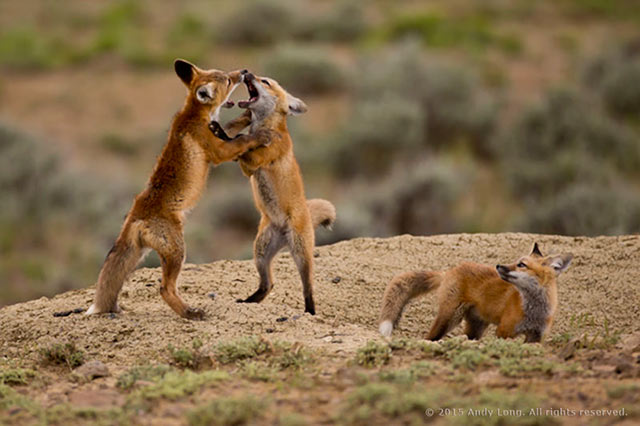
It’s a joy to watch and photograph baby foxes playing.
Every photographer wants to catch the peak of the action when photographing wildlife. Typically this peak consists of a movement, such as a bird taking off or landing on water, an animal eating or grooming, or maybe an animal pouncing through the air as it goes after its prey. Another high point occurs at the instant two animals come together and more often than not its when they touch each other through play, nuzzling or battle. And sometimes, the photographer will get lucky when a pair of animals you don’t think of as being in close proximity with one another move into the same scene.
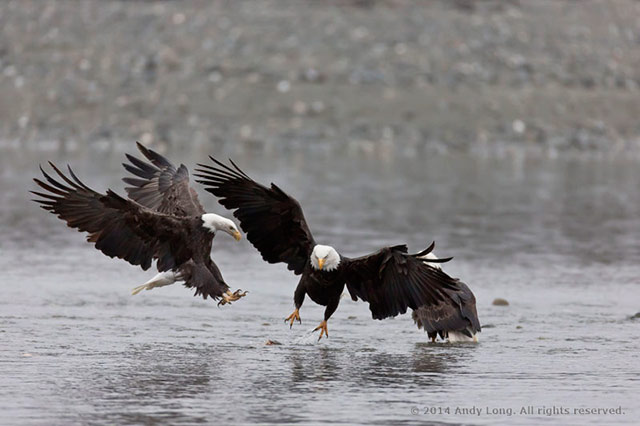
Did that fish actually escape all those Bald Eagle talons?
Most interaction is a spur-of-the-moment occurrence that might be missed if the photographer isn’t ready. The animal offers no advance warning they’re about perform in some manner. On some occasions, however, the situation is less temporary, and the action continues for several minutes. A good example of this happens when a mother bear and her young cub are together. As the young bear grows up and prepares for life on its own, it needs to learn to show dominance. While its interaction with its mother qualifies as playtime, especially if there isn’t a sibling, the youngster is also being taught how to fight. Of course, the mother could take her offspring out with a single swipe of her paw. Instead, she maintains the lesson for an extended period of time, having as much fun as her young. Making lots of images of this can ultimately provide the photographer with some very interesting photos.
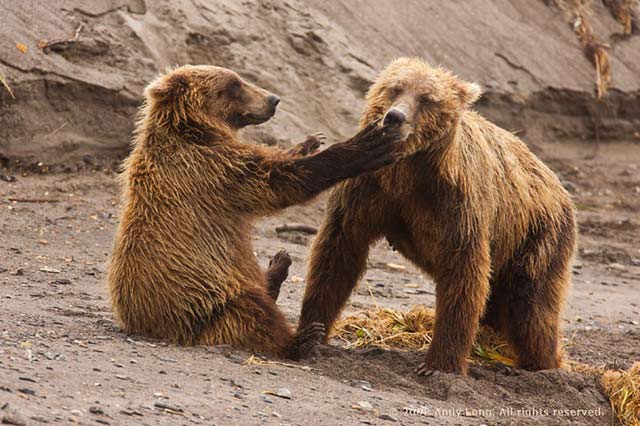
Bear Slap
As two bears tussle about, still images can capture aggressive poses that seem to represent bears really fighting with each other, positions that communicate tender touching, or cute shots of the pair resting together after outbursts of energy.
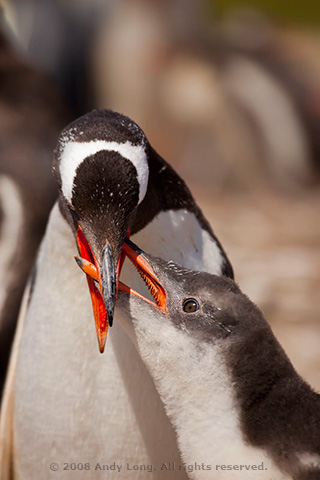
Gentoo Penguin Feeding
Mother and young action provides some of the best images of interaction between animals. There are certain to be several opportunities while the mother is feeding her newborn. The younger the newborn, the more times it needs to be fed. If a photographer is near a colony of birds, the opportunities multiply–especially in the Falkland Islands by a colony of one of several penguin species. Lots of action happens in and around the colony, so finding the right setting becomes the primary challenge. The photographer should set up with a good light angle and wait. More often than not, a pair will separate from the group, making images of them isolated from the rest easier.
Another good photography opportunity occurs when there are numerous mothers with their young. This brings about a chance to capture the young playing together. Once they get started, their interaction and playfulness is almost non-stop. A photographer can even catch images of youngsters by themselves as they bounce around play-fighting, which is their typical behavior even at a very young age.
On the bear trip, my photographic juices and those of everyone with me started flowing anew when a wolf approached over a small rise. Although it never came close enough for full-frame image, the mere sight of it inspired a tap dance of shutter buttons being pushed. When it crossed a shallow creek not far behind a bear, the uniqueness of the setting increased. Even though the two animals weren’t standing next to each other, a chance to catch photos of a wolf and an Alaska brown bear in the same scene has to be special.
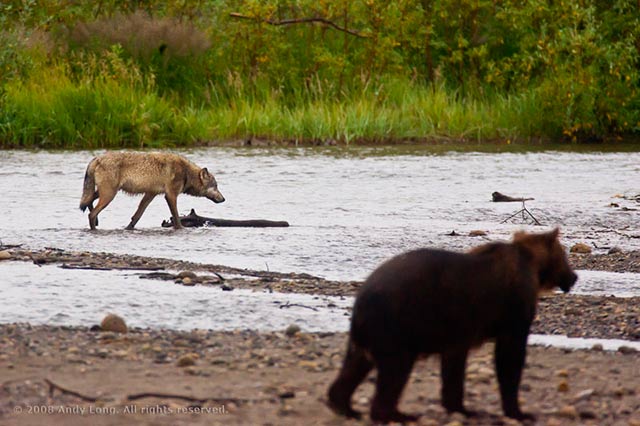
A wolf and an Alaska Brown Bear in one image
creates great excitement for any photographer.
Being able to see this type of behavior is fun, no matter if an award-winning image is taken or not. Half of the enjoyment of doing photography is venturing out to see what’s going on in the world around us. Capturing photos that preserve the moment or that allow sharing the experience with others just adds to the thrill of seeing it happen. However, the ultimate enjoyment comes when I push the shutter button. After such a perfect moment, I sometimes swear that I’ll give all my gear away and never take another picture. (Those who stand next to me as I watch a mother bear and her cub play at fighting know this won’t happen any time soon.)
A particular time that often presents good interaction photos is mating season. Lots of opportunities arise to make images of a male and a female together standing in both warm and fuzzy poses as well as performing other behaviors that are uncommon at other times of the year. Also, a photographer who remains watchful in the wilderness long enough is bound to witness some new scene, such as a male bluebird passing a worm to its mate as a sign of bonding. Bonding scenes make great images, no matter what species the pair of animals is.
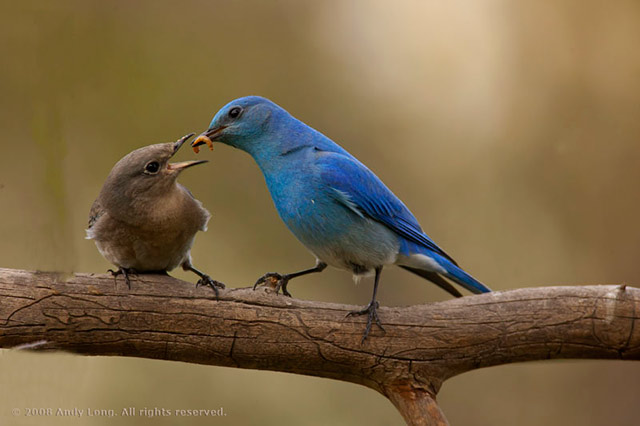
Be patient and you too can capture those special moments.
As two animals approach each other, the photographer should move into position so the light is at a good angle, if possible, and be ready when the animals are finally close to one another. A serious wildlife photographer should have and hone a keen sense of anticipation. Just going out to try to make a great photo by luck isn’t going to result in many top-notch photos. However, by watching and studying animal behavior over an extended period of time, one can learn what’s likely to happen next. Setting up where the light is at the right angle is key, but knowing something is about to happen is even more important.
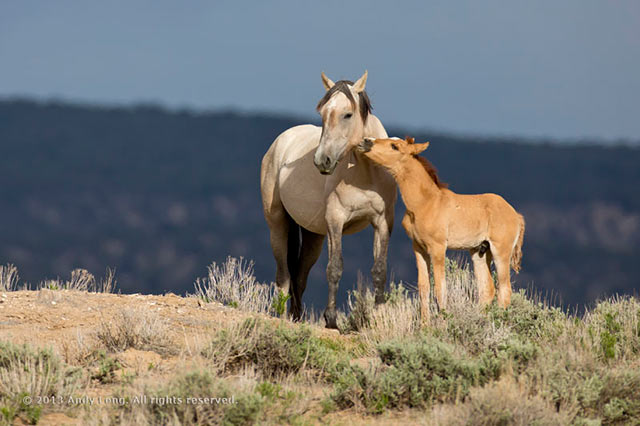
A gentle moment in the wild horse kingdom.
Few photographers take the study of animal behavior seriously. They need to be observant in the field. Even when they’re busy photographing, they need to also be taking mental notes about the behaviors of the subjects that they’re watching. If they do, the next time they see similar behaviors, they’ll be prepared and come home with a better photograph. However, simply being with a subject for a few minutes is just a start. A serious wildlife photographer should spend several hours watching and learning about a single animal or a group of animals.
Frequently, when I’m trying to capture animal action and behavior, I try to use a shutter speed of at least 1/1000th of a second. If it’s not a bright, sunny day, this can be accomplished by bumping up the ISO on the camera. With the quality of the cameras today, I’m not afraid to go up to 800 or even 1000 ISO to get a fast enough shutter speed. The shutter speed can never be too fast when I’m photographing wildlife.
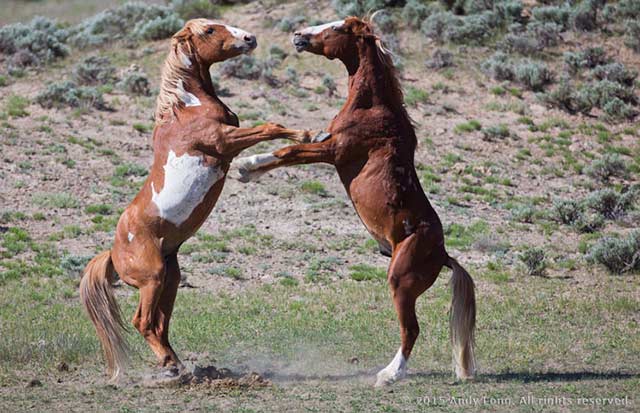
A sparing match takes place between two wild horses at
Sand Wash Basin in Colorado. And the winner is…?
Another suggestion I offer is to go ½ stop from wide open for the aperture just to provide a little more depth-of-field for the setting. I recommend this technique regardless of whether there’s one animal in the frame or a pair. Getting the little extra depth may mean a difference in sharp antlers from the nose of an elk or a bit of softness on the back tines. If the light allows, I suggest you stop down even more to get the depth-of-field necessary to keep as much of the animal as possible in focus.
Whatever images you capture of animals interacting with each other, they are sure to cause you to remember the experience. These moments make wildlife photography special. Look for them. Wait for them. Be ready for them. No matter how long it takes to capture that special action, it will be more than worth it.
by Andy Long
First Light Photo Workshops
All text & photos: © 2015 Andy Long. All rights reserved.

Leave a Reply